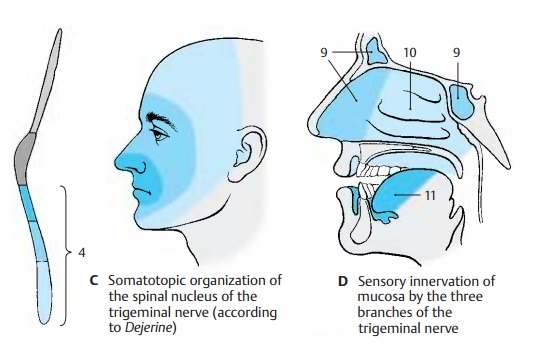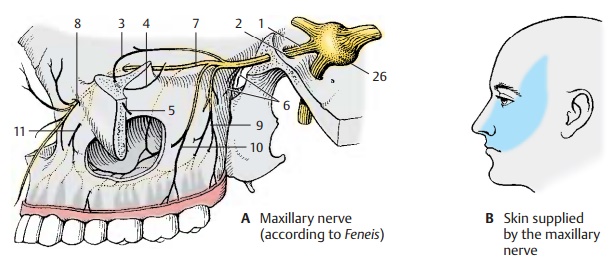Chapter: Human Nervous System and Sensory Organs : Brain Stem and Cranial Nerves
Facial Nerve - Cranial Nerves (V, VII - XII)

Facial Nerve
The seventh cranial nerve supplies motor fibers to the muscles of facial expression; in a nerve bundle emerging separately from the brain stem, called the intermediate nerve, it carries taste fibers and viscero-efferent secretory (parasympathetic) fibers. The motor fibers (AB1) originate from the large, multipolar neurons in the nucleus ofthe facial nerve (AB2). They arch aroundthe abducens nucleus (AB3) (internal genu ofthe facial nerve) and emerge on the lateralaspect of the medulla oblongata from the lower border of the pons. The cells of the preganglionic secretory fibers (AB4) form the superior salivatory nucleus (AB5). The taste fibers (AB6) originate from the pseudo-unipolar cells in the geniculate ganglion (BC7) and terminate in the cranial section of the solitary nucleus (AB8). The visceroefferentand taste fibers do not arch around the ab-ducens nucleus but join the ascending limb of the nerve and emerge as intermediatenerve (B9) between the facial nerve and thevestibulocochlear nerve.

Both parts of the nerve pass through the inner auditory canal, the internal acousticmeatus (petrous part of temporal bone, in-ternal acoustic pore,, and enter the facial canal as a nerve trunk. At the bend of the nerve in the petrous bone (externalgenu of the facial nerve) lies the geniculate ganglion(BC7). The canal continues abovethe tympanic cavity and turns caudally toward the stylomastoid foramen (BC10), through which the nerve leaves the skull. The nerve ramifies into terminal branches (parotid plexus) (E11) in the parotidgland.
The greater petrosal nerve (BC12), the stapedius nerve (BC13), and the chorda tympani (BC14) branch off inside the facialcanal. Thegreater petrosal nerve(pregan-glionic secretory fibers for the lacrimal gland, nasal glands, and palatal glands) originates from the geniculate ganglion, ex-tends through the hiatus for the lesserpetrosal nerve into the cranial cavity andover the anterior aspect of the petrous bone through the foramen lacerum and finallythrough the pterygoid canal to the pterygo-palatine ganglion (C15). Thestapedius nervesupplies the stapedius muscle in the middle ear. Thechorda tympani (BC14) branches off above the stylomastoid foramen, runs beneath the mucosa through the tympanic cavity and further to the petrotympanic fissure, and finally joins the lingual nerve (C16). It contains taste fibersfor the anterior two-thirds of the tongue (D) and preganglionic fibers for the subman-dibular and sublingual glands as well as various lingual glands.

Before it enters the parotid gland, the facial nerve gives off the posterior auricular nerve (E17) as well as branches to the posterior belly of the digastric muscle(CE18) and to the stylohyoid muscle (C19). The parotid plexus gives off the temporal branches (E20), the zygomatic branches (E21), thebuccalbranches (E22), the marginal mandibular branch (E23), and the cervical branch (E24)for the platysma (see vol. 1). The branches provide innervation to all the muscles of fa-cial expression.
Ramifications of the cervical branch lying beneath the platysma form the superficialcervical ansa by anastomosing withbranches of the sensory transverse cervical nerve. The small branches departing from the ansa are mixed sen-sorimotor nerves. The terminal ramifica-tions of temporal branches, buccal branches, and marginal mandibular branch form similar plexuses with branches of the trigeminal nerve.
Clinical Note: Injury to the nerve results inatony of all muscles of the affected half of the face. The mouth region drops, and the eye can no longer close (F). There is increased sensitivity to sound, hyperacusis.
C25 Trigeminal ganglion.

Maxillary Nerve (A, B)
The maxillary nerve (A1) gives off a menin- geal branch and then passes through the round foramen (A2) into the pterygopalatine fossa, where it divides into the zygomatic nerve, the ganglionic branches (pterygo- palatine nerves), and the infraorbital nerve. The zygomatic nerve (A3) reaches through the inferior orbital fissure to the lateral wall of the orbit. It gives off a communicating branch, which secretory (parasympathetic) fibers from the pterygopalatine ganglion for the lacrimal gland, to the lacrimal nerve and divides int the zygomaticotemporal branch (A4) (temple) and the zygomaticofacial branch (A5) (skin over the zygomatic arch). The ganglionic branches (A6) are two or three fine filaments palatine ganglion. The fibers provide sensory innervation to the upper pharynx, nasal cavity, and hard and soft palates.

The infraorbital nerve (A7) reaches through the inferior orbital fissure into the orbit and through the infraorbital canal (A8) to the cheek, where it supplies the skin between lower eyelid and upper lip (B). It gives off the posterior superior alveolar nerves (A9) (molar teeth), the middle superior alveolar nerve (A10) (premolar teeth), and the ante- rior superior alveolar nerves (A11) (incisors). The nerves form the superior dental plexus above the alveoli.
Mandibular Nerve (C – F)
After passing through the oval foramen and giving off a meningeal branch (C12) in the in-fratemporal fossa, the nerve divides into theauriculotemporal nerve, the lingual nerve,the inferior alveolar nerve, the buccal nerve, and the pure motor branches.

The pure motor branches leave the mandibu-lar nerve shortly after its passage through the foramen: the masseteric nerve (C13) for the masseter muscle (F14), the deep temporalnerves (C15) for thetemporal muscle(F16), and the pterygoid nerves (C17) for the ptery- goid muscles (F18). Motor fibers for the ten- sor tympani muscle and for the tensor muscle of the velum palatinum run to the otic gan- glion and emerge from it as nerve of the tensor tympani muscle and as nerve of the tensor veli palatini muscle. The auriculotemporal nerve (C19) (temporal skin, external acoustic meatus, and tym- panic membrane) usually originates with two roots that embrace the middle menin- geal artery and then unite to form the nerve. The lingual nerve (C20) de- scends in an arch to the base of the tongue and supplies sensory fibers to the anterior two-thirds of the tongue (D). It receives its taste fibers from the chorda tympani (facial nerve). The inferior alveolar nerve (C21) con- tains motor fibers for the mylohyoid muscle and the anterior belly of the digastric muscle; furthermore, it contains sensory fibers, which enter the mandibular canal and give off numerous inferior dental branches (C22) for the teeth of the lower jaw. The main branch of the nerve, the mental nerve (C23), passes through the mental for a men and supplies sensory fibers to the chin, the lower lip, and the skin over the body of the mandible (E). The buccal nerve (C24) passes through the buccinator muscle (C25) and supplies the mucosa of the cheek.
BC26 trigeminal ganglion.

Related Topics